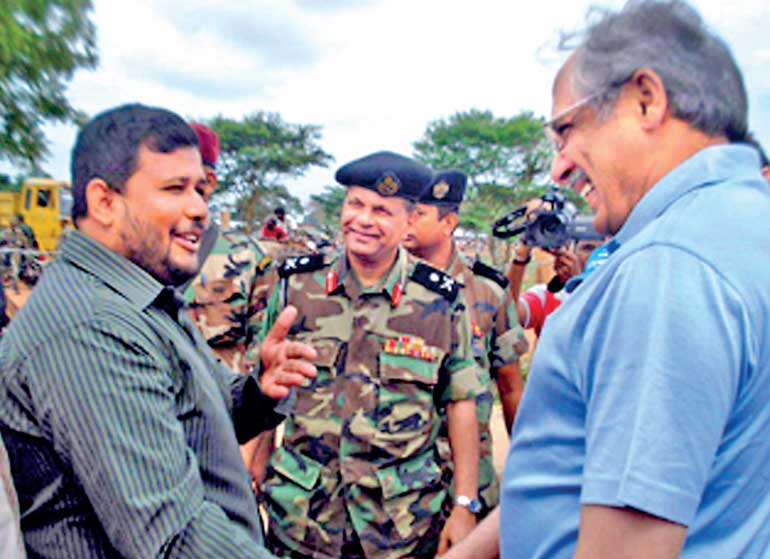Saturday May 11, 2024
Saturday May 11, 2024
Monday, 20 November 2017 00:24 - - {{hitsCtrl.values.hits}}
The Sri Lankan refugee displacement village, which entered the global spotlight as the world’s largest refugee camp at one time, has been brought back to life as part of a new $ 1.8 million national apparel initiative at the village level.

Sri Lankan Minister of Industry and Commerce Rishad Bathiudeen (centre) at Menik Camp Village after having launched the Mini Apparel Centre on 14 November. He was joined by some aspiring apparel entrepreneurs from the Menik Camp Village (at right)
“Reconciliation would be a distant dream without the provision of proper livelihoods to IDPs and war-affected,” said Sri Lanka’s Minister of Industry and Commerce Rishad Bathiudeen on 14 November. Minister Bathiudeen was addressing more than 200 people at Menik Farm Village, located southwest of Vavuniya, during the inauguration ceremony of one of the mini factories under the 150 Mini Apparel Factories Program led by his ministry.
This village was the location of the former Menik Farm Displacement Camp (or simply Menik Farm), which was considered the world’s largest refugee camp at one time, sheltering close to 300,000 refugees. The displacement camp had eight zones and after a four-year run, it was closed at the end of 2012 as all refugees were resettled. This area now has a village -the Menik Farm Village.
Minister Bathiudeen’s Rs. 287 million ($ 1.87 million) project aims at setting up 150 mini apparel factories across the country in support of the Unity Government’s one million new jobs program.
The Sri Lanka Institute of Textile and Apparel (SLITA), functioning under Minister Bathiudeen, is tasked with the project, which seeks to bring 3,000 women across the country into self-employment in apparel and handlooms.
The project is centred around 20-women strong small-scale mini apparel factories and has higher goals - to produce high-quality apparel later on rather than handlooms alone and to become part of the world-class global apparel supply chain that Sri Lanka is reputed for.

Sri Lankan Minister of Industry and Commerce Rishad Bathiudeen (left), when he was Minister of Resettlement and Disaster Relief Services), with Maj. Gen. G.A. Chandrasiri (centre) and the then visiting UN Special Envoy Vijay Nambiar (right) during an inspection tour of the Menik Farm Displacement Camp in May 2009
Each factory therefore is provided with a range of high-end apparel machinery that is of an industry standard in Sri Lanka - single needle machines, cutting tables and even button-hole machines. A special feature of the project is that close to 50% of all mini factories are dedicated to a forgotten demographic from the three decades of conflict - the helpless war widows of the Northern and Eastern provinces.
“73 centres of the 150 are dedicated to conflict-affected families such as you,” said Minister Bathiudeen, addressing the people at Menik Camp – all of them Tamil - who flocked to take part in the traditional opening ceremony and witnessing the birth of the their apparel factory in their own village.
“Of the 73 mini factories in the North and East, 38 will be in the Northern Province while 35 will be in the East. The Jaffna District will get three and there will be 13 factories for Vavuniya. So far 135 centres have commenced training and after six months, these centres will become mini apparel factories, each employing 22 persons. The trained women thereafter can form their own textile cooperative or business partnerships with regional buyers through supply subcontracts. We want these 150 factories to form their own apparel companies or cooperatives one day and share their profits among them.”
Minister Bathiudeen and his SLITA officials, including Director General of SLITA (Engineer) Robert Peries, thereafter distributed the apparel machinery to the 20 women and war widows and also launched their training sessions.
The Menik Farm Displacement Camp is a familiar site for Minister Bathiudeen, who, as the then Minister of Resettlement and Disaster Relief Services in charge of resettlement of refugees at the close of the war, was a frequent visitor to the site to review the progress of relief distribution and resettlement.